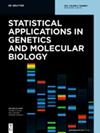核心家族遗传关联分析在大家庭样本中的有效性探讨
IF 0.9
4区 数学
Q3 Mathematics
Statistical Applications in Genetics and Molecular Biology
Pub Date : 2015-12-01
DOI:10.1515/sagmb-2015-0056
引用次数: 3
摘要
摘要将大家庭划分为核心家庭,应用为核心家庭设计的遗传关联方法是家族遗传学研究中普遍采用的一种方法。来自同一大家庭的核心家庭的基因型和表型之间的依赖性是由于被测标记与风险变异的遗传连锁或由于基因-环境相互作用导致的遗传效应的家族特异性而产生的。这引起了人们对在假定核心家庭独立的情况下所作推断的有效性的关注。我们确实从理论上证明,在适用于疾病病例及其基因型父母的条件逻辑回归分析中,基于朴素模型的系数方差估计器低估了真实方差。然而,模拟风险变量的实际效应大小以及这种效应在家庭之间的变化表明,低估是可以忽略不计的。仿真还表明,与稳健的经验估计器相比,基于模型的方差估计器的效率更高。因此,我们建议使用基于模型的方差估计器来推断遗传变异的影响。本文章由计算机程序翻译,如有差异,请以英文原文为准。
On the validity of within-nuclear-family genetic association analysis in samples of extended families
Abstract Splitting extended families into their component nuclear families to apply a genetic association method designed for nuclear families is a widespread practice in familial genetic studies. Dependence among genotypes and phenotypes of nuclear families from the same extended family arises because of genetic linkage of the tested marker with a risk variant or because of familial specificity of genetic effects due to gene-environment interaction. This raises concerns about the validity of inference conducted under the assumption of independence of the nuclear families. We indeed prove theoretically that, in a conditional logistic regression analysis applicable to disease cases and their genotyped parents, the naive model-based estimator of the variance of the coefficient estimates underestimates the true variance. However, simulations with realistic effect sizes of risk variants and variation of this effect from family to family reveal that the underestimation is negligible. The simulations also show the greater efficiency of the model-based variance estimator compared to a robust empirical estimator. Our recommendation is therefore, to use the model-based estimator of variance for inference on effects of genetic variants.
求助全文
通过发布文献求助,成功后即可免费获取论文全文。
去求助
来源期刊
CiteScore
1.20
自引率
11.10%
发文量
8
审稿时长
6-12 weeks
期刊介绍:
Statistical Applications in Genetics and Molecular Biology seeks to publish significant research on the application of statistical ideas to problems arising from computational biology. The focus of the papers should be on the relevant statistical issues but should contain a succinct description of the relevant biological problem being considered. The range of topics is wide and will include topics such as linkage mapping, association studies, gene finding and sequence alignment, protein structure prediction, design and analysis of microarray data, molecular evolution and phylogenetic trees, DNA topology, and data base search strategies. Both original research and review articles will be warmly received.

 求助内容:
求助内容: 应助结果提醒方式:
应助结果提醒方式:


